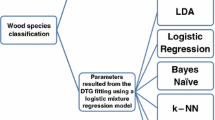Abstract
The quality of the pulp and paper produced in eastern Canada is affected by the proportions of black spruce (Picea mariana), balsam fir (Abies balsamea) and jack pine (Pinus banksiana) present in the wood chips used. A rapid analytical method capable of differentiating the wood of these three species of conifer is a prerequisite to developing a procedure to determine these proportions. This differentiation was achieved through the use of an electronic nose made up of an array of conductive polymer-carbon black composites-based sensors. The procedure is rapid and involves training and validation of the e-nose using reference wood samples followed by identification of unknown samples. Principal Component Analysis is performed on the smell-prints obtained during the training phase. Complete discrimination of the sapwood and heartwood of the three conifers was achieved. The reference and the unknown samples must be measured under identical conditions.
Zusammenfassung
Die Qualität von Zellstoff und Papier, die in Ostkanada produziert werden, wird durch unterschiedliche Anteile von Picea mariana, Abies balsamea und Pinus banksiana beeinflusst. Eine schnelle analytische Methode, um die jeweilige Art dieser drei Nadelhölzer zu unterscheiden, ist ein Voraussetzung dafür, diese Anteile zu bestimmen. Die Differenzierung wurde erreicht durch Anwendung einer elektronischen Geruchssonde, deren Sensoren aus einem Kompositwerkstoff aus Polymeren und Ruß bestehen. Die Methode ist schnell und erfordert ein Training und die Bewertung der Geruchssonde durch Vergleich mit Referenzproben und nachträgliches Bestimmen nicht identifizierter Proben. Während der Trainingsphase wird eine Hauptkomponenten-Analyse angewendet. Mit der Methode konnte die vollständige Differenzierung zwischen Splint- und Kernholz der drei Nadelholzarten erreicht werden. Die Kontrollproben und unbekannten Proben müssen dabei unter identischen Bedingungen gemessen werden.


Similar content being viewed by others
References
Daubner LR, Barbour J (1992) Automated lumber species sorting using ion mobility spectrometry. Paper presented at the Application of Advanced Informatics to the Forest Industry, Vancouver, May 25
Jamroz WR, Tremblay J, Wong B (1995) Method and apparatus for non-contact and rapid identification of wood species. U.S. Patent #5406378
Law KN, Kokta BV, Mao CB (2000) Differentiation of jack pine from other conifers by the analysis of color appearance from chemical tests. J Wood Chem Technol 20:61–70
Lawrence AH (1989) Rapid characterization of wood species by ion mobility spectrometry. J Pulp Paper Sci 15:J196–J199
Lawrence AH, Barbour RJ, Sutcliffe R (1991) Identification of wood species by ion mobility spectrometry. Anal Chem 63:1217–1221
Lebow PK, Brunner CC, Maristany AG, Butler DA (1996) Classification of wood surface features by spectral reflectance. Wood Fiber Sci 28:74–90
Muñoz BC, Steinthal G, Sunshine S (1999) Conductive polymer-carbon black composites-based sensor arrays for use in an electronic nose. Sensor Rev 19:300–305
Nault JR, Manville JF (1992) Differentiation of some Canadian coniferous woods by combined diffuse and specular reflectance fourier transform infrared spectroscopy. Wood Fiber Sci 24:424–431
Nault JR, Manville JF (1997) Species differientiation of two common lumber mixes by Diffuse Reflectance Fourier Transform Infrared (DRIFT) spectroscopy. Wood Fiber Sci 29:1–9
Sum ST, Singleton DL, Paraskevopoulos G, Irwin RS, Barbour RJ, Sutcliffe R (1991) Laser-excited fluorescence spectra of Eastern SPF wood species. An optical technique for identification and separation of wood species. Wood Sci Technol 25:405–413
Pichette A (1998) Contribution au développement de méthodes analytiques utiles pour l’évaluation des proportions des conifères dans les copeaux. Ph.D thesis, Faculty of Forestry, Université Laval
Pichette A, Garneau FX, Jean FI, Riedl B, Girard M (1998) Chemical differences between the wood extracts of jack pine (Pinus banksiana), black spruce ( Picea mariana) and balsam fir (Abies balsamea) from Eastern Canada. J Wood Chem Technol 18:427–438
Riedl B, Garneau FX, Pichette A, Stevanovic-Janesic T, Jean FI (1999) Caractérisation des extractibles de bois de conifères et autres arbres. Actualité chimique canadienne 52:22–24
Sundberg K, Orsa F, Wilkstrom B, Holmbom B, Eckman R (1997) Assessment of pine and spruce wood proportions in pulp production by the analysis of resin acids. Paperi Ja Puu 79:327–329
Züercher E, Kucera LJ, Bariska M, Moy L (1997) Electronic odour testing of woods. Holz Roh- Werkstoff 55:281–285
Author information
Authors and Affiliations
Corresponding author
Rights and permissions
About this article
Cite this article
Garneau, FX., Riedl, B., Hobbs, S. et al. The use of sensor array technology for rapid differentiation of the sapwood and heartwood of Eastern Canadian spruce, fir and pine. Holz Roh Werkst 62, 470–473 (2004). https://doi.org/10.1007/s00107-004-0508-8
Published:
Issue Date:
DOI: https://doi.org/10.1007/s00107-004-0508-8




